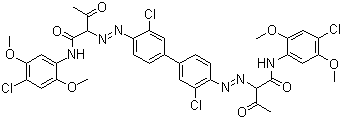Pigmento amarillo 83
| nombre del producto | PIGMENTO AMARILLO 83 |
| Sinónimos | CIPigment Yellow 83; CIPY83; PY83; PY83 |
| CI | 21108 |
| NO CAS. | 5567-15-7 |
| EINECS | 226-939-8 |
| Peso molecular | 818.49 |
| Fórmula molecular | C36H32Cl4N6O8 |
| Densidad | 1,43 g / cm3 |
| Color | Polvo amarillo |
![]()
Fórmula de estructura molecular:

Propiedades de solidez del pigmento amarillo 83:
| Resistencia a la luz | 5-6 |
| Resistencia al calor (℃) | 200 |
| Resistencia al agua | 5 |
| Resistencia al aceite | 5 |
| Resistencia ácida | 5 |
| Resistencia a los álcalis | 5 |
| Resistencia al alcohol | 4-5 |
polvo amarillo La resistencia al calor es estable a 200 ℃. Otras propiedades, como la resistencia a la luz, la resistencia a los disolventes, la resistencia a los ácidos y los álcalis son excelentes.
Aplicación principal: Tinta a base de agua, Tinta a base de solvente, Pintura, Plástico, Impresión textil
Tenemos varios grados y propiedades de pigmentos para satisfacer las necesidades de los diferentes clientes; especifique su aplicación y requisitos para que podamos recomendarlos en consecuencia. Correo electrónico: sy@sypigment.com
Descripción del producto del pigmento amarillo 83:
Pigmnet Yellow 83 has a specific surface area of 69m2/g, and has excellent light resistance, heat resistance, solvent resistance and migration resistance. It gives a stronger red light yellow than pigment yellow 13 (similar to pigment yellow 10, and its strength is twice as high) . Suitable for all kinds of printing inks, automotive coatings (OEM), latex paint; widely used in plastic coloring, soft PVC does not migrate and bleed even at low concentrations, light fastness is 8 (1/3SD), Grade 7 (1/25SD); has high coloring strength (1/3SD) in HDPE, and the pigment concentration is 0.8%; it can also be used for solvent-based wood coloring, art color, and brown with carbon black; the quality of the pigment can meet For fabric printing and dyeing, the dry and wet treatment will not affect the shade.
Pigment Yellow 83 is an organic compound that is classified as a diarylide pigment. It is used as a yellow colorant.
The compound is synthesized from three components. Treatment of 2,5-dimethoxy-4-chloroaniline with diketene gives an acetoacetylated aniline. This compound is then coupled to the bisdiazonium salt obtained from 3,3'-dichlorobenzidine.
TDS (Pigment Yellow 83) MSDS (Pigment Yellow 83)Sinónimos
- Pigment yellow 83
- 5567-15-7
- C.I. PIGMENT YELLOW 83
- PIGMENTYELLOW83
- UNII-67HO7X7FV3
- 67HO7X7FV3
- 2,2′-[(3,3′-Dichloro[1,1′-biphenyl]-4,4′-diyl)bis(azo)]bis[N-(4-chloro-2,5-dimethoxyphenyl)-3-oxobutyramide] PY-83
- 2-[[2-chloro-4-[3-chloro-4-[[1-(4-chloro-2,5-dimethoxyanilino)-1,3-dioxobutan-2-yl]diazenyl]phenyl]phenyl]diazenyl]-N-(4-chloro-2,5-dimethoxyphenyl)-3-oxobutanamide
- C.I. 21108
- 2,2′-((3,3′-Dichloro(1,1′-biphenyl)-4,4′-diyl)bis(azo))bis(N-(4-chloro-2,5-dimethoxyphenyl)-3-oxobutyramide)
Butanamide, 2,2′-[(3,3′-dichloro[1,1′-biphenyl]-4,4′-diyl)bis(azo)]bis[N-(4-chloro-2,5-dimethoxyphenyl)-3-oxo- - 2,2′-[(3,3′-dichlorobiphenyl-4,4′-diyl)di(E)diazene-2,1-diyl]bis{N-[4-chloro-2,5-bis(methyloxy)phenyl]-3-oxobutanamide}
- Butanamide, 2,2′-((3,3′-dichloro(1,1′-biphenyl)-4,4′-diyl)bis(azo))bis(N-(4-chloro-2,5-dimethoxyphenyl)-3-oxo-
- EINECS 226-939-8
- CI 21108
- EC 226-939-8
- Pigment yellow 83, tech.
- Butanamide, 2,2′-((3,3′-dichloro-1,1′-biphenyl)-4,4′-diyl)bis(azo)bis(N-(4-ch- loro-2,5-dimethoxyphenyl)-3-oxo-
- SCHEMBL306830
- DTXSID1021453
- HY-D0283
- Pigment Yellow 83, Technical grade
- MFCD00071958
- 2,2′-((3,3′-Dichloro-1,1′-biphenyl)-4,4′-diyl)bis(azo)bis(N-(4-ch- loro-2,5-dimethoxyphenyl)-3-oxobutanamide)
- Acetoacetanilide, 2,2”-((3,3′-dichloro-4,4′-biphenylylene)bis(azo))bis(4′-chloro-2′,5′-dimethoxy-
- CS-0010186
- F21285
- 567P157
- A857611
- W-109157
- Q16977693
- Butanamide, 2,2′-((3,3′-dichloro(1,1′-biphenyl)-4,4′-diyl)bis(2,1-diazenediyl))bis(N-(4-chloro-2,5-dimethoxyphenyl)-3-oxo-
- Butanamide,2,2′-[(3,3′-dichloro[1,1′-biphenyl]-4,4′-diyl)bis(azo)]bis[N-(4-chloro-2,5-dimethoxyphenyl)-3-oxo-
Nombre IUPAC: 2-[[2-chloro-4-[3-chloro-4-[[1-(4-chloro-2,5-dimethoxyanilino)-1,3-dioxobutan-2-yl]diazenyl]phenyl]phenyl]diazenyl]-N-(4-chloro-2,5-dimethoxyphenyl)-3-oxobutanamide
InChI: InChI=1S/C36H32Cl4N6O8/c1-17(47)33(35(49)41-27-15-29(51-3)23(39)13-31(27)53-5)45-43-25-9-7-19(11-21(25)37)20-8-10-26(22(38)12-20)44-46-34(18(2)48)36(50)42-28-16-30(52-4)24(40)14-32(28)54-6/h7-16,33-34H,1-6H3,(H,41,49)(H,42,50)
InChIKey: NKXPXRNUMARIMZ-UHFFFAOYSA-N
SONRISAS canónicas: CC(=O)C(C(=O)NC1=CC(=C(C=C1OC)Cl)OC)N=NC2=C(C=C(C=C2)C3=CC(=C(C=C3)N=NC(C(=O)C)C(=O)NC4=CC(=C(C=C4OC)Cl)OC)Cl)Cl
| Nombre de la propiedad | El valor de la propiedad |
| Peso molecular | 818.5 |
| XLogP3-AA | 9.2 |
| Recuento de donantes de enlaces de hidrógeno | 2 |
| Recuento de aceptores de enlaces de hidrógeno | 12 |
| Recuento de bonos giratorios | 15 |
| Masa exacta | 818.100623 |
| Masa monoisotópica | 816.103573 |
| Área de superficie polar topológica | 179 Ų |
| Recuento de átomos pesados | 54 |
| Cargo formal | 0 |
| Complejidad | 1250 |
| Recuento de átomos de isótopos | 0 |
| Recuento de estereocentros de átomos definidos | 0 |
| Recuento de estereocentros de átomos indefinidos | 2 |
| Recuento de estereocentros de enlaces definidos | 0 |
| Recuento de estereocentros de enlace indefinido | 0 |
| Recuento de unidades unidas covalentemente | 1 |
| El compuesto está canonizado | Sí |



